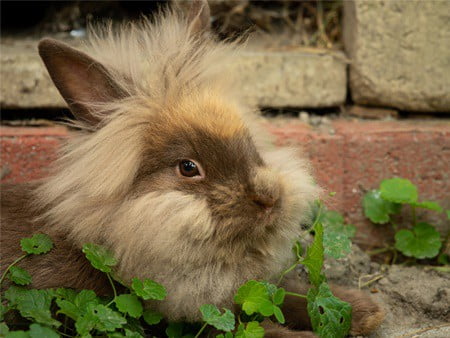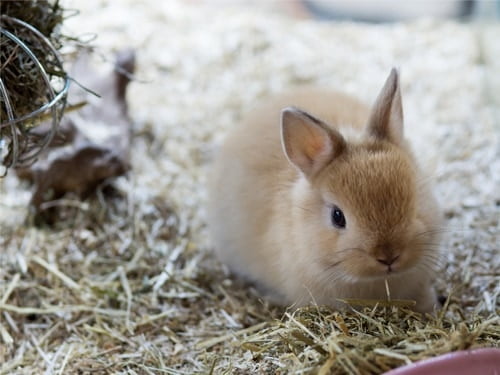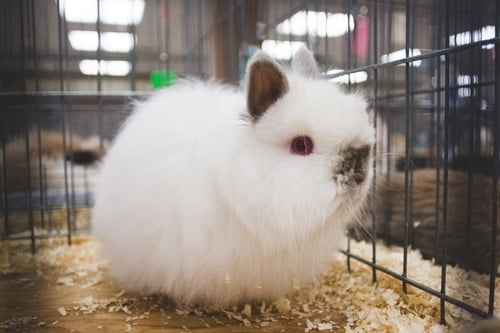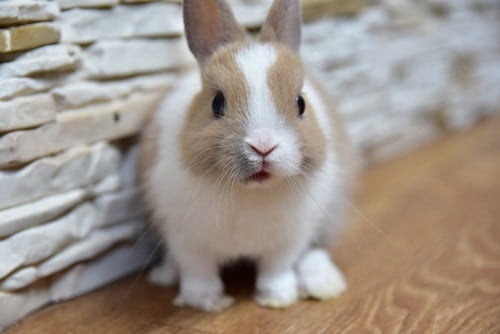The smaller the rabbit, the longer its lifespan. Dwarf rabbits tend to outlive other breeds.
On average, dwarf rabbit breeds live up to 8 to 10 years. Of course, care and genetics play a huge role. Furthermore, rabbits that have been spayed or neutered, are given a proper diet and are housed in sanitary conditions can live longer than others.
The Netherland Dwarf is a popular example of dwarf rabbit breeds. It’s among the smallest domesticated rabbits in the world and has a lifespan of 10 to 12 years. By contrast, larger breeds weighing 13 to 16 pounds may only live for 5 to 6 years.
Life Expectancy of Dwarf Rabbits
| Breed | Lifespan |
|---|---|
| Dwarf Lop | 9 to 10 years |
| Dwarf Lionhead Rabbit | 8 to 10 years |
| Dwarf Hotot Rabbit | 7 to 10 years |
| Netherland Dwarf Rabbit | 10 to 12 years |
| Columbia Basin Pygmy Rabbit | 3 to 5 years |
| Mini English Angora Rabbit | 6 to 10 years |
| Jersey Wooly Rabbit | 7 to 10+ years |
| Britannia Petite Rabbit | 6 to 10 years |
| Miniature Cashmere Lop Rabbit | 9 to 10 years |
How Long Do Dwarf Lop Rabbits Live?
The Dwarf Lop is a small-to-medium-sized dwarf rabbit that can weigh up to 5 pounds. It has an average lifespan of 9 to 10 years but can live longer with proper care and mental stimulation.
Dwarf or miniature rabbit breeds live longer than bigger or giant breeds. Therefore, Dwarf Lops are much likely to live beyond 10 years, unlike French lops with a lifespan of only 5 years.
Most problems with dwarf lops are connected to diet. Your rabbit’s diet should predominantly consist of hay. Pellets, fruits, and vegetables can be provided in moderation or as treats.
Dwarf Lops are not vulnerable to any hereditary health issues. But taking proper care of your pet can improve the quality of your life, and even reduce your vet bills.
Be sure to check your rabbit’s teeth regularly for overgrown teeth. Rabbit teeth grow perpetually and can only be controlled by continual wear (such as from chewing on hay).
Overgrown teeth, if left untreated, can grow into the jaws and mouth and cause discomfort and life-threatening infections. Offer hay to your dwarf rabbit as this will naturally file down its teeth.
How Long Do Dwarf Lionhead Rabbits Live?
The average lifespan of the Lionhead rabbit is 8 to 10 years. The Lionhead rabbit is a small rabbit that weighs no more than 3.5 pounds. The lifespan of this breed is highly dependent on the care you offer it. A proper diet is another vital factor that can prolong its lifespan.
Providing the right type of housing that is protected from direct sunlight, draft and moisture will also play a monumental role in keeping your rabbit healthy and content. Because of their heavy coats, Dwarf Lionhead Rabbits can easily succumb to the heat if housed outdoors in the summer.
Exercise and play are also equally vital and can help prevent stress in captive Dwarf Lionhead Rabbits. Avoiding stress as much as you can also increase your rabbit’s lifespan.

Spaying and neutering a rabbit also allows it to outlive rabbits that haven’t been altered. These procedures are not only crucial for controlling pet populations, but they also help prevent fatal cancers from developing in dwarf rabbits.
Unaltered dwarf rabbits have a much higher risk of developing uterine or testicular cancers as early as the age of two. These cancers are typically life-threatening, and the risk for cancer increases with age. Since spaying or neutering rabbits rarely leads to the development of these cancers, altering your rabbit is highly recommended for your pet’s overall lifespan and health.
How Long Do Dwarf Hotot Rabbits Live?
The Dwarf Hotot is a tiny, compact dwarf breed that weighs no more than 2.25 to 3.5 pounds when fully grown. The average lifespan of a Dwarf Hotot is 7 to 10 years, but its small size can allow it to live well into its teenage years. The key is to offer it a healthy diet and the right type of care.
Unless you plan on breeding your Dwarf Hotot, you must spay or neuter your rabbits as it reduces their risk of uterine cancer, testicular cancer, and other reproductive system-related diseases.
Make sure that your rabbits are vaccinated against myxomatosis and viral hemorrhagic disease. You must check for ticks, fleas, and mites. Regularly deworming your Dwarf Hotot is also recommended.
Check your rabbit’s teeth to make sure they have not overgrown. If you notice overgrown teeth in your Dwarf Hotot, include more hay in your rabbit’s diet and offer it gnawing toys. Malocclusion is a common issue in rabbits that may cause an overbite, underbite or other malformations.
Always check if your rabbit is grooming itself normally. If you notice your rabbit is dirty, it may be a cause for concern. Unclean fur can increase a rabbit’s risk of flystrike. Always spot clean dirty or matted fur with a damp towel and never bathe your rabbit. Bathing a rabbit can cause stress and may even lead to cardiac issues.
As a rabbit self-grooms, it may ingest some of its fur. Over time the accumulated fur can block the digestive system and cause furballs. If you suspect your Dwarf Hotot has a furball issue, give it a laxative and see your vet if hairballs are affecting your rabbit’s health or lifestyle.
How Long Do Netherland Dwarf Rabbits Live?
The Netherland Dwarf is among the smallest rabbits in the world, weighing no more than 2.5 pounds. It can live up to 12 years, and even longer with proper care and housing.
There are a few severe illnesses you may have to protect a Netherland Dwarf against. Depending on the country you live in, you may not have to vaccinate your rabbit. You must take your rabbit to a vet and check if your rabbit is at risk of any diseases.

Many steps can help you ensure that your rabbit’s teeth are in healthy condition. Feeding your rabbit hay and rabbit pellets can help improve its teeth. Chewing toys are another great tool for rabbit dental health.
Proper housing conditions are also a must. Keep your rabbit’s cage in an area of your yard or home where there are no drafts or direct sunlight. High temperatures and cold weather can be harmful to small breeds such as the Netherland Dwarf, so do your best to protect your rabbit from harsh weather conditions.
How Long Do Columbia Basin Pygmy Rabbits Live?
The Columbia Basin Pygmy Rabbit is a near-extinct species of rabbit that normally survives for up to 5 years. Weighing less than 1 lb, there aren’t any breed-specific or hereditary diseases that endanger this species. However, some factors may play a role in its extinction.
Loss of natural habitat, as a result of developments, fires and clearings are the main reason for them wiped out. Even in ideal conditions, the average life expectancy of a Columbia Basin Pygmy rabbit is only 3 to 5 years because their size makes them easy prey for predators. The mortality rate of adult Columbia Basin Pygmy Rabbit is an alarming 88%.
Another factor that endangers this breed is their rate of reproduction. Unlike its relatives, the Columbia Basin Pygmy Rabbit isn’t a high-yielding breeder. To ensure its survival, the breed was crossed with other pygmy rabbits in conservation programs.
Hybrids of Columbia Basin Pygmy Rabbits with about 75% of the breed’s original genetic makeup have now been introduced to the wild. The last genetically pure Columbia Basin Pygmy Rabbit passed away in 2009.
How Long Do Mini English Angora Rabbits Live?
The Mini English Angora Rabbit, also known as the Dwarf Angora, has an average lifespan of 6 to 10 years. It’s a small breed that weighs only 3.5 pounds when fully grown.
As with any dwarf rabbit, most problems with the Mini English Angora Rabbit kept in captivity relate to poor diets. A Dwarf Angora’s diet should consist of 80 to 90% hay and 10% rabbit pellets, fruit, and vegetables. Keep in mind that the amount of food should be determined according to the size and age of your rabbit.
Ear mites, mosquitoes, and rabbit fleas are common issues in this breed. Screening your rabbit’s hutch and using a flea powder if your rabbit is exposed to wild rabbits can help. A Mini English Angora Rabbit can be vaccinated against Calicivirus if this disease is an issue in your area.
Mini English Angora Rabbits are vulnerable to high heat and cold weather, especially if they are housed permanently outdoors. Keeping your dwarf rabbit outdoors in poorly ventilated or draughty conditions increases its risk of “snuffles.” Snuffles is a term given to describe a common infectious respiratory illness, called Pasteurella multocida in rabbits.
Other diseases to look out for include Entertisis, which occurs when there is a sudden change in your bunny’s diet, and Coccidiosis – a protozoan parasite in the intestine or liver.
How Long Do Jersey Wooly Rabbits Live?
A fully grown Jersey Wooly weighs 2.5 to 3.5 pounds, and it isn’t uncommon for one to live up to 10 years. The lifespan of a Jersey Wooly depends on numerous factors, including care and genetics.
A common myth about Jersey Woolys is that the ones that have had litters die sooner. However, this hasn’t been scientifically proven. A large number of rabbit breeders report having health Jersey Woolys despite them having multiple litters. They claim that the ones with litters live just as long as the ones that haven’t had any babies.
However, this doesn’t mean that you shouldn’t spay or neuter a Jersey Wooly. Unless you’re a breeder, altering your rabbit is a great way to add years to your pet’s life. Not neutering or spaying your rabbit can increase its risk of developing life-threatening tumors.

How Long Do Britannia Petite Rabbits Live?
The Britannia Petite is a dwarf-sized rabbit, but it isn’t categorized as a dwarf because it doesn’t carry the dwarf gene. According to the Rockefeller Institute for Medical Research, dwarfism occurs naturally in rabbits due to a genetic mutation.
With proper care, a Britannia Petite can live around 6 to 10 years and even longer.
In Britain, this breed is known as the Polish rabbit. However, in the United States, the name was changed to Britannia Petite due to an already recognized breed called the Polish rabbit.
The Britannia Petite doesn’t have any health problems associated with its breed. However, owners should regularly check their rabbits for common issues, such as overgrown teeth. Overgrown teeth normally occur when a rabbit is given a poor diet that lacks hay.
If your rabbit shows signs of poor appetite, doesn’t seem to behave normally or isn’t releasing the same amount of droppings, look for signs of overgrown teeth. Overgrown teeth can grow into the jaw and cause severe pain in bunnies.
A proper diet also ensures that digestive issues are kept at bay. For example, diarrhea caused by a poor rabbit can increase a rabbit’s risk of flies during warmer weather conditions, especially if housed outdoors.
When a rabbit isn’t able to groom itself properly, flies can lay eggs on its fur. When the eggs hatch, they consume your rabbit – a fatal condition called flystrike. Therefore, always ensure that your rabbit is given a balanced diet and regularly check for any flies, especially near the bottom.
It’s also recommended that you give your rabbit a pea-sized dose of deworming paste twice a year to keep your rabbit’s health in check. You must also check your rabbit’s ears for any ear mites.
How Long Do Miniature Cashmere Lop Rabbits Live?
The Miniature Cashmere Lop is a small-sized dwarf breed that is generally hardy. Its average lifespan is around 9 to 10 years, and with proper care, you can expect your lop to live even longer.
Like with other breeds, you must check your rabbit’s teeth for signs of overgrown teeth. Always provide your rabbit with fibrous food, such as hay and green veggies to wear its teeth down.
Flystrike is another common problem in Miniature Cashmere Lops. rabbits are at a higher risk of flystrike if they are overweight and cannot groom themselves.
Make sure your pet is vaccinated against myxomatosis and VHD. You must also regularly treat your Miniature Cashmere Lop for fleas, ticks, and worms.
How to Increase Your Dwarf Rabbit’s Lifespan
Even though dwarf rabbits are tiny, their living spaces do not have to be small. Aim for a cage that is at least 18×24 inches and 14 inches high. If you’re including a litter box, be sure to add more space.
For dwarf rabbits, the bigger their cage, the better. This is because they need plenty of space to play, run around in and stretch. This gives them mental stimulation. Unfortunately, most rabbit owners believe that keeping a rabbit in a comfortable cage is enough to offer it mental stimulation.
While rabbits are well-capable of living outdoors and indoors with large areas to play in, they need plenty of interaction with toys and even human companions. Offering them plenty of toys to chew on and play with can help them stay healthy and content.
Dwarf rabbits that aren’t given enough space and enrichment aren’t as healthy as rabbits that do. Therefore, if you’re looking to have a rabbit that lives well into its double-digit years, you have to make sure that it has plenty of space.
Allow your rabbit to play outside its cage at least once a day. You can do this in a well-protected and fenced area of your yard or a rabbit-proofed area of your home. Keep wiring and plastic items away from your rabbits as they are keen gnawers.
Chewing on unsafe materials can cause illnesses in rabbits that can take away years from their lives. Gnawing at electrical cords can also lead to electrocution and death in rabbits.
If you haven’t already guessed, dwarf rabbits are very tiny and are easily intimidated. Make sure you provide your rabbit with a calm and quiet space in your home or yard.
Extreme amounts of stress from loud noises, a boisterous pet or children can cause shock in these tiny rabbits, eventually leading to their death.
Early Detection of GI Stasis
GI stasis can cause them to stop eating and die for no obvious reason. The condition occurs when the normal peristaltic muscular contractions that push food through the intestines slow down.
According to research by the University of Miami, a rabbit’s intestine can undergo GI stasis for a number of reasons, such as:
- Dehydration
- Stress
- Pain from an underlying disorder (e.g. dental problems, gas, infections or urinary tract disorders)
- Intestinal blockage
- Insufficient crude fiber in the diet
If left untreated, the condition can lead to the complete termination of normal intestinal movement, resulting in a painful death within a short period.
If your rabbit stops producing feces or stops eating, see a vet immediately. If 12 hours have passed, the condition is an emergency and needs immediate treatment.
Symptoms of GI stasis include little to no fecal pellets. Sometimes feces may stick to your rabbit’s bottom. Occasionally, small fecal pellets may be enclosed in a clear or yellow mucus. Treat the condition as an emergency as soon as you detect it.
Additional Care Tips for Small Rabbits
Diseases in dwarf rabbits are rare when they are raised in sanitary conditions and are offered adequate care.
Rabbits, especially dwarf varieties, have fragile bones in their spines. They need support on the belly or bottom when they are being picked up. This makes dwarf rabbits unsuitable for young children.
Spayed or neutered rabbits that are housed indoors with proper care can have a lifespan of 8 to 12 years. Dwarf rabbits generally live longer than larger breeds so they make excellent companion animals if you want a tiny rabbit that will live for longer.

